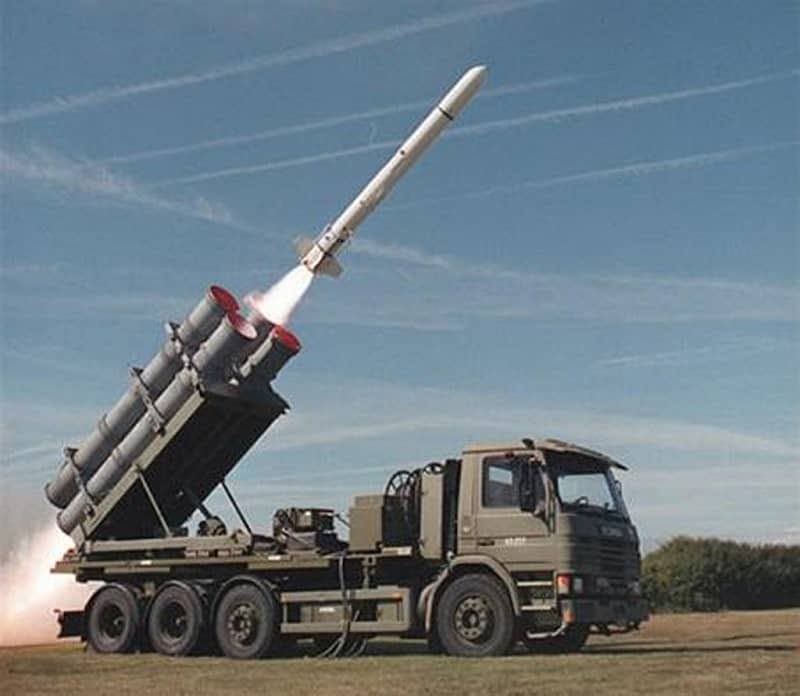As Ukraine has received its first batch of truck-mounted Harpoon Anti-Ship Missiles (AShM) from the US, its top defense acquisition official said Russia’s Vasily Bekh support vessel was sunk on June 17 by a version of the missile fired from a flatbed truck.
1st Evidence Of Russia-Operated Iranian Suicide Drone Emerges In Ukraine; Kiev Claims Downing Shahed-136 UAV
Russia’s ‘Most Advanced’ Electronic Warfare (EW) Jamming Pod Mounted On Su-30 Fighter Seized By Ukraine
This comes in the backdrop of Ukraine receiving the first batch of vehicle-mounted Harpoon missiles, which US officials said their Ukrainian counterparts consider essential for their coastal defense.
Secretary of Defense, Llyod Austin, announced the road-mobile Harpoons on June 15 as a part of a $650 million Ukraine Security Assistance fund.

US & Allies Team Up To Arm Ukraine
The Harpoon weighs under 700 kilograms and flies at subsonic speeds with a 225-kilogram fragmentation warhead at ranges of 90 to 220 kilometers (536 miles). It has a diameter of 34.4 centimeters and is about 12 feet long.
Following the sinking of the Vasily Bekh, Russia itself claimed to have destroyed Harpoons on July 18 and July 24. In the former, it claimed to have struck an “industrial enterprise” in Odesa that stored the missile. The second strike declared the sinking of a Ukrainian warship and Harpoon missiles in the Odesa port.
In a background briefing call with journalists in June after the package’s announcement, unnamed Department of Defense (DoD) and Pentagon officials surprisingly claimed that the missiles did not come from the US but its allies.
“For Harpoon systems specifically, working with allies and partners, we will provide truck-mounted launch capability and then supported by donations from other allies and partners,” the official added. Thus, combined efforts (from friendly nations) will support these two capabilities (launcher and rockets), with the launchers coming from the US and the missiles coming from NATO allies.
⚡️#Ukraine received from the West #Harpoon missiles on a car platform, – said a representative of the US Department of Defense.#UkrainianArmy#UkraineWar #UkraineRussianWar #Ukrainian #UkraineWillWin #Ukraina #UkraineRussiaWar pic.twitter.com/OsXRZxDiuA
— 🇺🇦 UkraineNewsLive🇺🇦 (@UkraineNewsLive) September 7, 2022
The consternation about not depleting their inventory in support of Ukraine worries the US military leadership. This is because the Pentagon officials said they are “pushing” such systems “to the front quickly” only after “taking into account other considerations such as their (own) readiness.”
Ukraine has long asked for long-range artillery, like more M-777 lightweight towed artillery (which Russia has claimed to have destroyed in large numbers).
Installing Harpoons From A Ship To A Truck
Speaking at the press conference, Undersecretary of Defense for Acquisition, Bill LaPlante, recalled the ad-hoc mid-June arrangement that involved taking the Harpoons off a ship and putting them on flatbed trucks.
“We got them off the ship, put the Harpoons, the modules on the flatbed truck, and then a different flatbed truck for the power source, connected a cable between it, figured out was exportable,” LaPlante was quoted as saying by Defense One. On June 17, Russia’s Vasily Bekh support ship was sunk. A week later, Pentagon said the ship was sunk using a Harpoon.
While LaPlante did not disclose the country the missiles were taken from, it is likely to have been Denmark, as Ukraine had said on June 9 about having deployed Harpoons from the Scandinavian country. “So, this is a capability that provides them significantly stronger deterrence,” the official was quoted in the transcript of the call released by the DoD.
The official also said the Ukrainians have ranked coastal defense “at the top of their list of urgent needs.”
He also responded to a query by a journalist on what appeared to be a minimal number of only two such systems. “(That’s) because of what’s readily available that industry has that can be supplied in the near-term process to, again, make and have an effect on the near-term on the battlefield,” the official said.
US has procured the Harpoon launchers through a Request for Information (RFI) tendering process. This will “marry up with allies and partners with missile capabilities.”
The rapid procurement was wrapped up in a great 60 days through an enhanced dialogue with the industry. It asked for capabilities to be delivered in 30, 60, and 90 days yielding “1,300 responses from everybody,” according to LaPlante.
The transcript of the background briefing call also saw a reporter wondering why Harpoons were needed. It is because the journalists were given to understand that the Russian risk of an amphibious assault on Odesa for “opening another front” is “non-existent.”
Earlier in the interaction, the official had said, “Harpoon is intended for coastal defense,” and addressed the “negative impacts” of the Russian blockade of the Black Sea. This had raised Ukrainian fears about Russia targeting Odesa and other critical ports around the Black Sea.
To the question, the “Senior Defence official” replied that the provision of the Harpoon was not in response to any particular piece of new information but a combination of continued consultation with Ukraine and coastal defense still being near the top of their list.
- The author can be reached at satamp@gmail.com
- Follow EurAsian Times on Google News